Early Reading Development: Assessments, Inclusivity, and Planning
VerifiedAdded on 2023/06/05
|19
|3998
|499
Report
AI Summary
This report provides an overview of teaching early reading, covering various assessment types such as screening, progress monitoring, diagnostic, and outcome assessments. It defines running records and discusses their pros and cons, along with the use of an inclusive approach to inform decision-making in early reading development, particularly for students with dyslexia. The report includes a miscue analysis of running records, detailing correction, insertion, omission, repetition, reversal, and substitution errors. It presents findings on graphophonic, grammatical, and semantic errors, and concludes with a lesson plan focused on improving phonics and reading vocabulary, incorporating activities and strategies to enhance students' understanding of language and sound. Desklib provides access to similar solved assignments and resources for students.
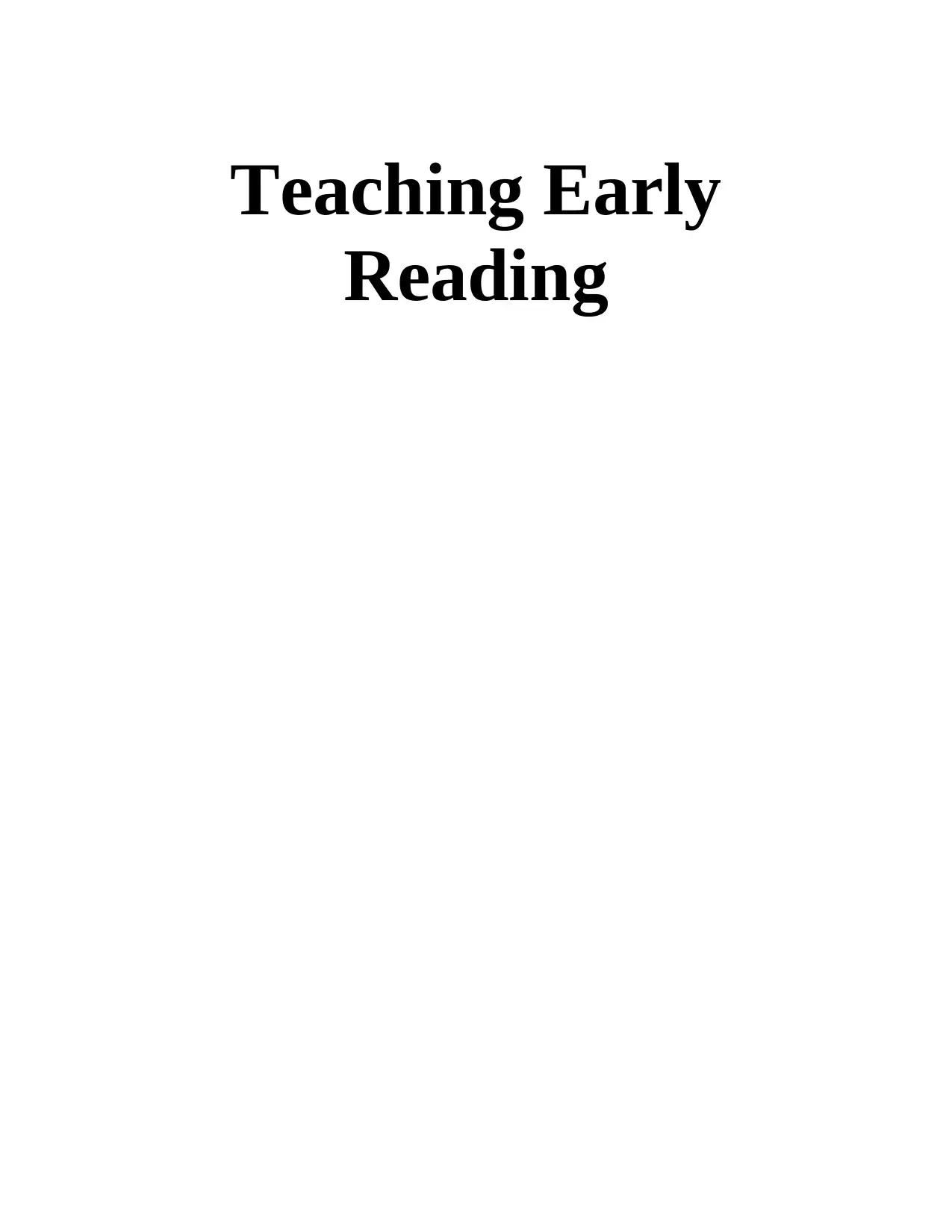
Teaching Early
Reading
Reading
Paraphrase This Document
Need a fresh take? Get an instant paraphrase of this document with our AI Paraphraser
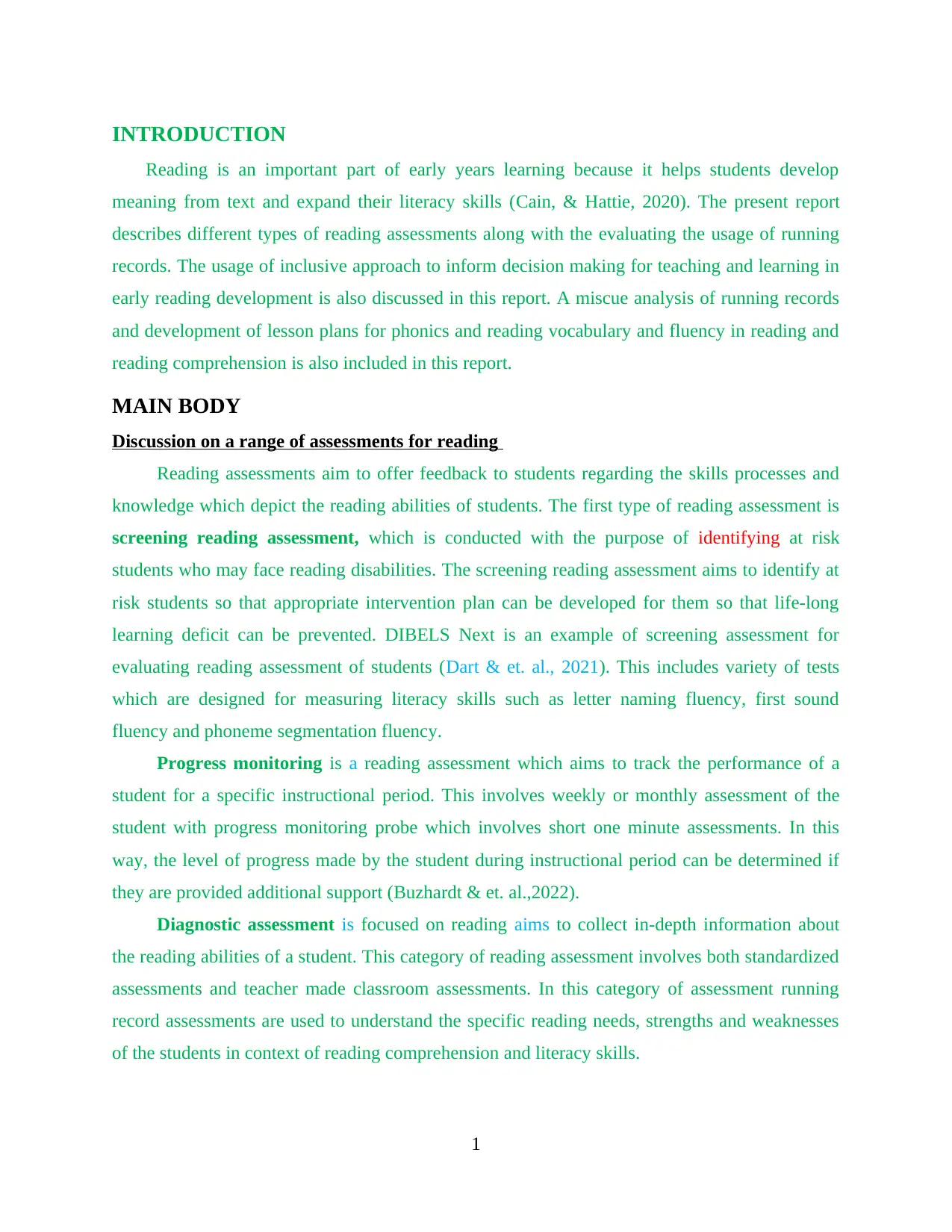
INTRODUCTION
Reading is an important part of early years learning because it helps students develop
meaning from text and expand their literacy skills (Cain, & Hattie, 2020). The present report
describes different types of reading assessments along with the evaluating the usage of running
records. The usage of inclusive approach to inform decision making for teaching and learning in
early reading development is also discussed in this report. A miscue analysis of running records
and development of lesson plans for phonics and reading vocabulary and fluency in reading and
reading comprehension is also included in this report.
MAIN BODY
Discussion on a range of assessments for reading
Reading assessments aim to offer feedback to students regarding the skills processes and
knowledge which depict the reading abilities of students. The first type of reading assessment is
screening reading assessment, which is conducted with the purpose of identifying at risk
students who may face reading disabilities. The screening reading assessment aims to identify at
risk students so that appropriate intervention plan can be developed for them so that life-long
learning deficit can be prevented. DIBELS Next is an example of screening assessment for
evaluating reading assessment of students (Dart & et. al., 2021). This includes variety of tests
which are designed for measuring literacy skills such as letter naming fluency, first sound
fluency and phoneme segmentation fluency.
Progress monitoring is a reading assessment which aims to track the performance of a
student for a specific instructional period. This involves weekly or monthly assessment of the
student with progress monitoring probe which involves short one minute assessments. In this
way, the level of progress made by the student during instructional period can be determined if
they are provided additional support (Buzhardt & et. al.,2022).
Diagnostic assessment is focused on reading aims to collect in-depth information about
the reading abilities of a student. This category of reading assessment involves both standardized
assessments and teacher made classroom assessments. In this category of assessment running
record assessments are used to understand the specific reading needs, strengths and weaknesses
of the students in context of reading comprehension and literacy skills.
1
Reading is an important part of early years learning because it helps students develop
meaning from text and expand their literacy skills (Cain, & Hattie, 2020). The present report
describes different types of reading assessments along with the evaluating the usage of running
records. The usage of inclusive approach to inform decision making for teaching and learning in
early reading development is also discussed in this report. A miscue analysis of running records
and development of lesson plans for phonics and reading vocabulary and fluency in reading and
reading comprehension is also included in this report.
MAIN BODY
Discussion on a range of assessments for reading
Reading assessments aim to offer feedback to students regarding the skills processes and
knowledge which depict the reading abilities of students. The first type of reading assessment is
screening reading assessment, which is conducted with the purpose of identifying at risk
students who may face reading disabilities. The screening reading assessment aims to identify at
risk students so that appropriate intervention plan can be developed for them so that life-long
learning deficit can be prevented. DIBELS Next is an example of screening assessment for
evaluating reading assessment of students (Dart & et. al., 2021). This includes variety of tests
which are designed for measuring literacy skills such as letter naming fluency, first sound
fluency and phoneme segmentation fluency.
Progress monitoring is a reading assessment which aims to track the performance of a
student for a specific instructional period. This involves weekly or monthly assessment of the
student with progress monitoring probe which involves short one minute assessments. In this
way, the level of progress made by the student during instructional period can be determined if
they are provided additional support (Buzhardt & et. al.,2022).
Diagnostic assessment is focused on reading aims to collect in-depth information about
the reading abilities of a student. This category of reading assessment involves both standardized
assessments and teacher made classroom assessments. In this category of assessment running
record assessments are used to understand the specific reading needs, strengths and weaknesses
of the students in context of reading comprehension and literacy skills.
1
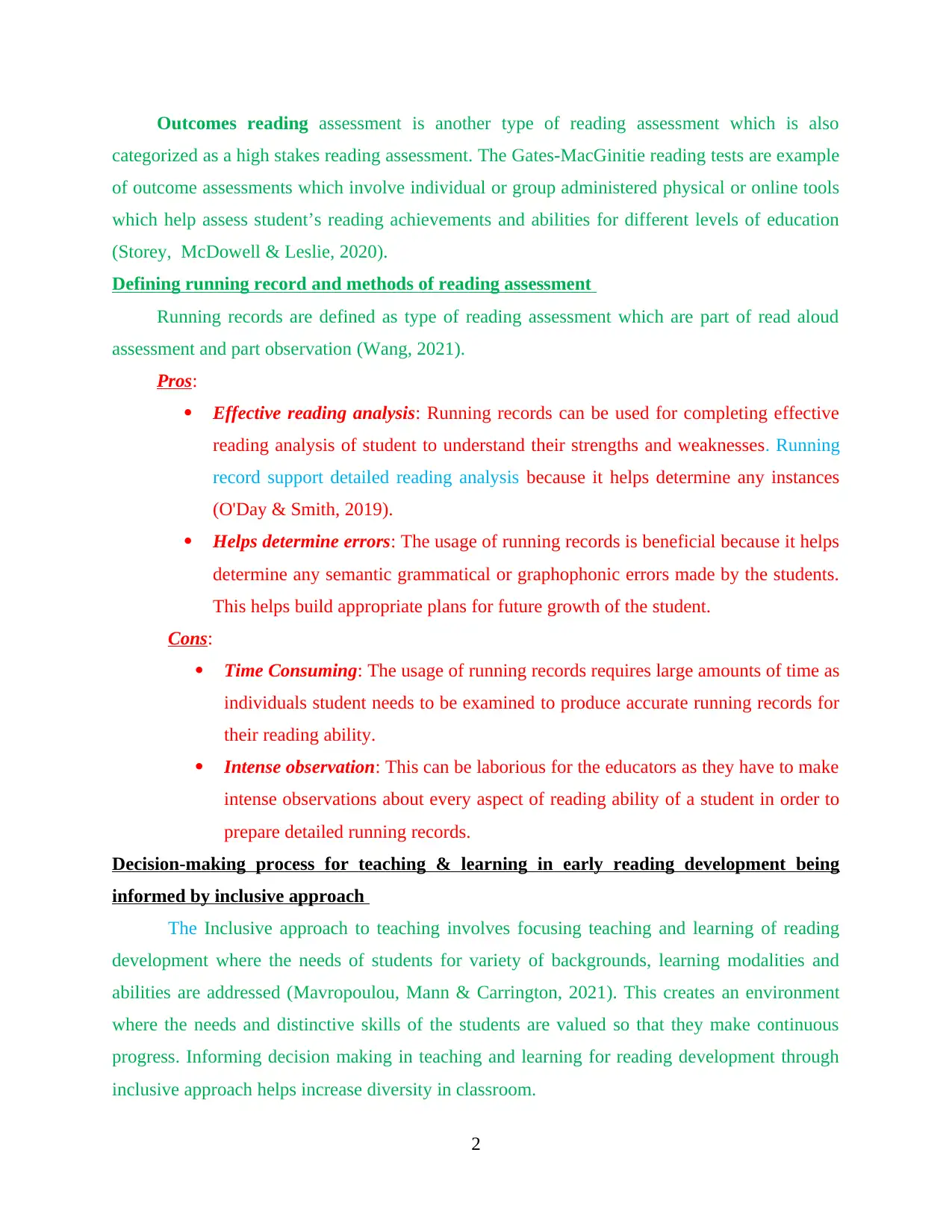
Outcomes reading assessment is another type of reading assessment which is also
categorized as a high stakes reading assessment. The Gates-MacGinitie reading tests are example
of outcome assessments which involve individual or group administered physical or online tools
which help assess student’s reading achievements and abilities for different levels of education
(Storey, McDowell & Leslie, 2020).
Defining running record and methods of reading assessment
Running records are defined as type of reading assessment which are part of read aloud
assessment and part observation (Wang, 2021).
Pros:
Effective reading analysis: Running records can be used for completing effective
reading analysis of student to understand their strengths and weaknesses. Running
record support detailed reading analysis because it helps determine any instances
(O'Day & Smith, 2019).
Helps determine errors: The usage of running records is beneficial because it helps
determine any semantic grammatical or graphophonic errors made by the students.
This helps build appropriate plans for future growth of the student.
Cons:
Time Consuming: The usage of running records requires large amounts of time as
individuals student needs to be examined to produce accurate running records for
their reading ability.
Intense observation: This can be laborious for the educators as they have to make
intense observations about every aspect of reading ability of a student in order to
prepare detailed running records.
Decision-making process for teaching & learning in early reading development being
informed by inclusive approach
The Inclusive approach to teaching involves focusing teaching and learning of reading
development where the needs of students for variety of backgrounds, learning modalities and
abilities are addressed (Mavropoulou, Mann & Carrington, 2021). This creates an environment
where the needs and distinctive skills of the students are valued so that they make continuous
progress. Informing decision making in teaching and learning for reading development through
inclusive approach helps increase diversity in classroom.
2
categorized as a high stakes reading assessment. The Gates-MacGinitie reading tests are example
of outcome assessments which involve individual or group administered physical or online tools
which help assess student’s reading achievements and abilities for different levels of education
(Storey, McDowell & Leslie, 2020).
Defining running record and methods of reading assessment
Running records are defined as type of reading assessment which are part of read aloud
assessment and part observation (Wang, 2021).
Pros:
Effective reading analysis: Running records can be used for completing effective
reading analysis of student to understand their strengths and weaknesses. Running
record support detailed reading analysis because it helps determine any instances
(O'Day & Smith, 2019).
Helps determine errors: The usage of running records is beneficial because it helps
determine any semantic grammatical or graphophonic errors made by the students.
This helps build appropriate plans for future growth of the student.
Cons:
Time Consuming: The usage of running records requires large amounts of time as
individuals student needs to be examined to produce accurate running records for
their reading ability.
Intense observation: This can be laborious for the educators as they have to make
intense observations about every aspect of reading ability of a student in order to
prepare detailed running records.
Decision-making process for teaching & learning in early reading development being
informed by inclusive approach
The Inclusive approach to teaching involves focusing teaching and learning of reading
development where the needs of students for variety of backgrounds, learning modalities and
abilities are addressed (Mavropoulou, Mann & Carrington, 2021). This creates an environment
where the needs and distinctive skills of the students are valued so that they make continuous
progress. Informing decision making in teaching and learning for reading development through
inclusive approach helps increase diversity in classroom.
2
⊘ This is a preview!⊘
Do you want full access?
Subscribe today to unlock all pages.

Trusted by 1+ million students worldwide
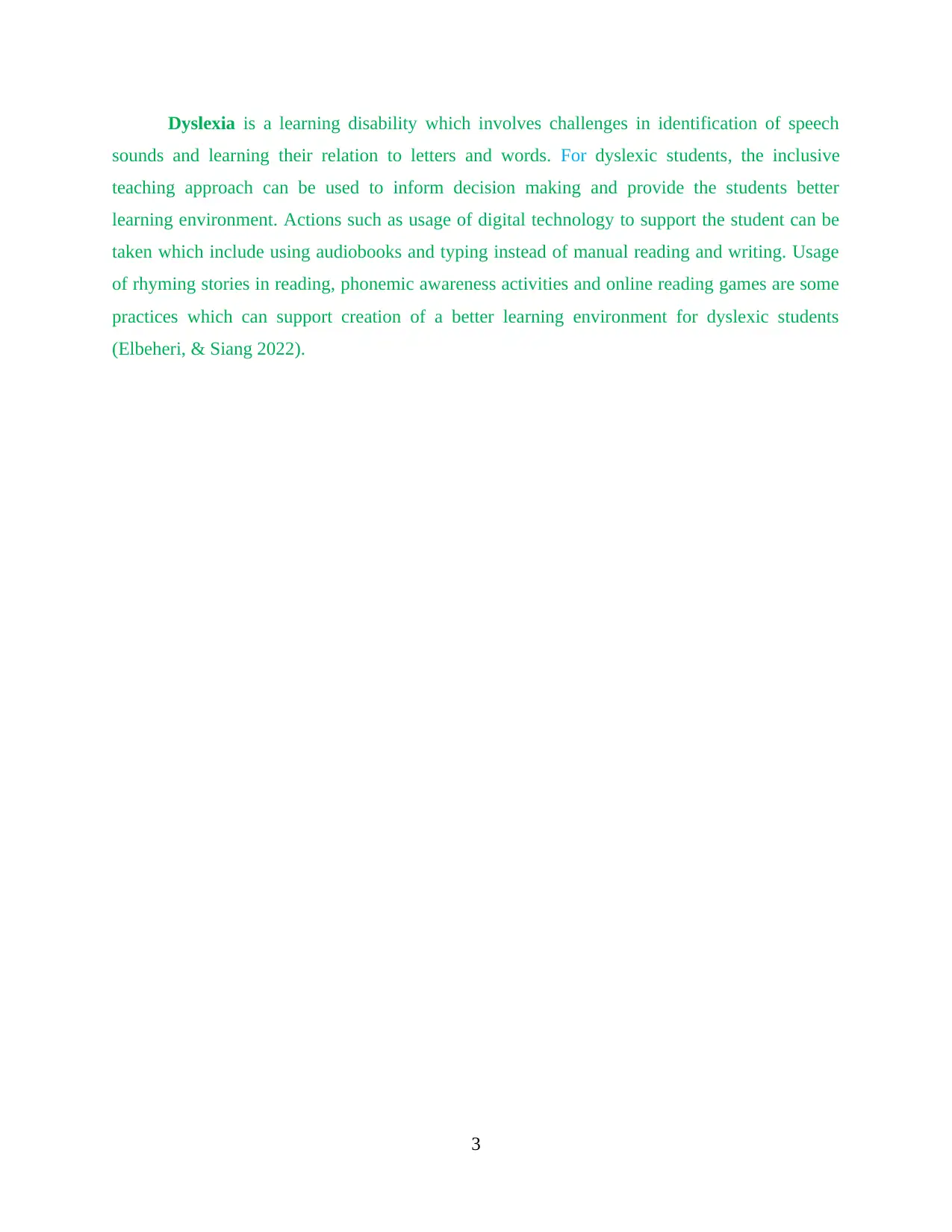
Dyslexia is a learning disability which involves challenges in identification of speech
sounds and learning their relation to letters and words. For dyslexic students, the inclusive
teaching approach can be used to inform decision making and provide the students better
learning environment. Actions such as usage of digital technology to support the student can be
taken which include using audiobooks and typing instead of manual reading and writing. Usage
of rhyming stories in reading, phonemic awareness activities and online reading games are some
practices which can support creation of a better learning environment for dyslexic students
(Elbeheri, & Siang 2022).
3
sounds and learning their relation to letters and words. For dyslexic students, the inclusive
teaching approach can be used to inform decision making and provide the students better
learning environment. Actions such as usage of digital technology to support the student can be
taken which include using audiobooks and typing instead of manual reading and writing. Usage
of rhyming stories in reading, phonemic awareness activities and online reading games are some
practices which can support creation of a better learning environment for dyslexic students
(Elbeheri, & Siang 2022).
3
Paraphrase This Document
Need a fresh take? Get an instant paraphrase of this document with our AI Paraphraser
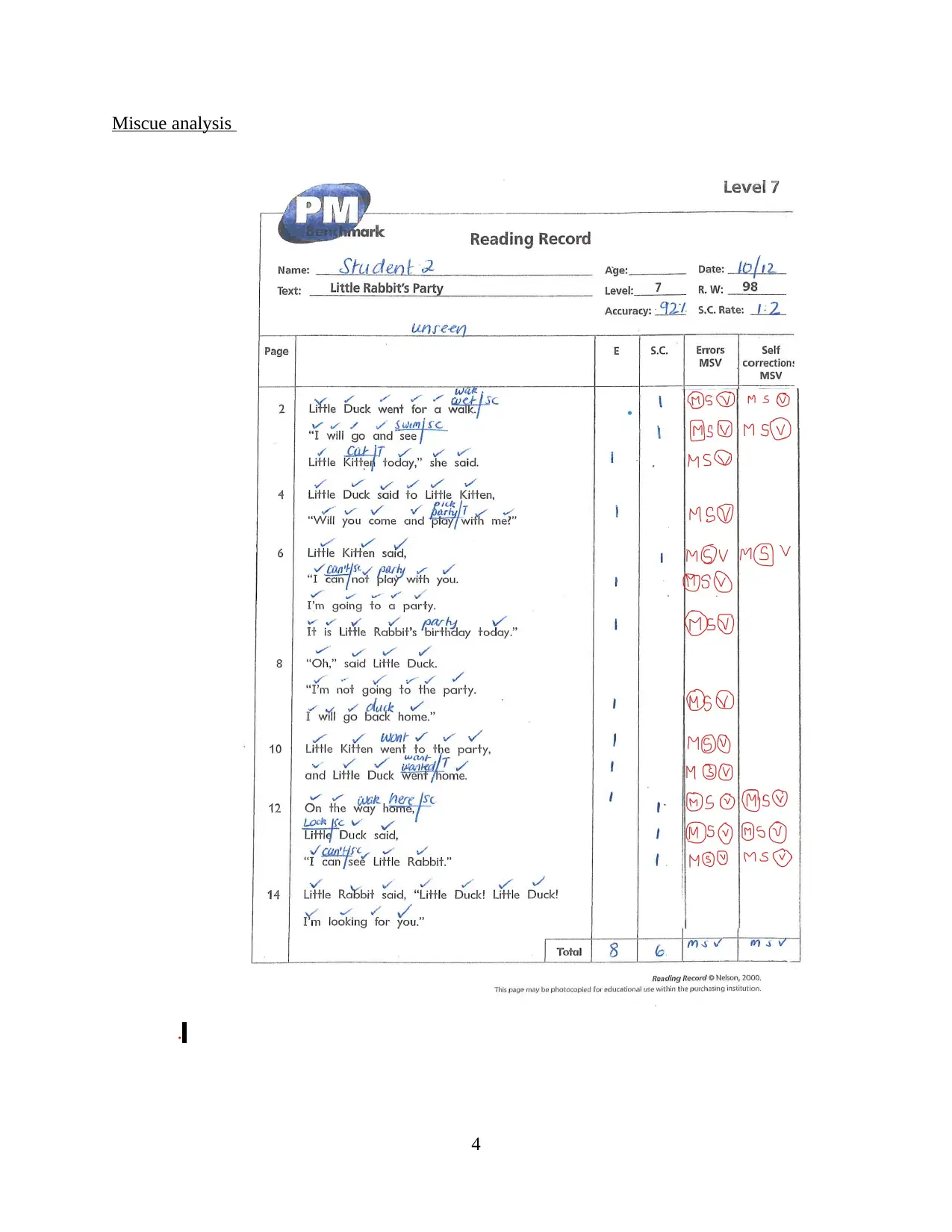
Miscue analysis
.
4
.
4
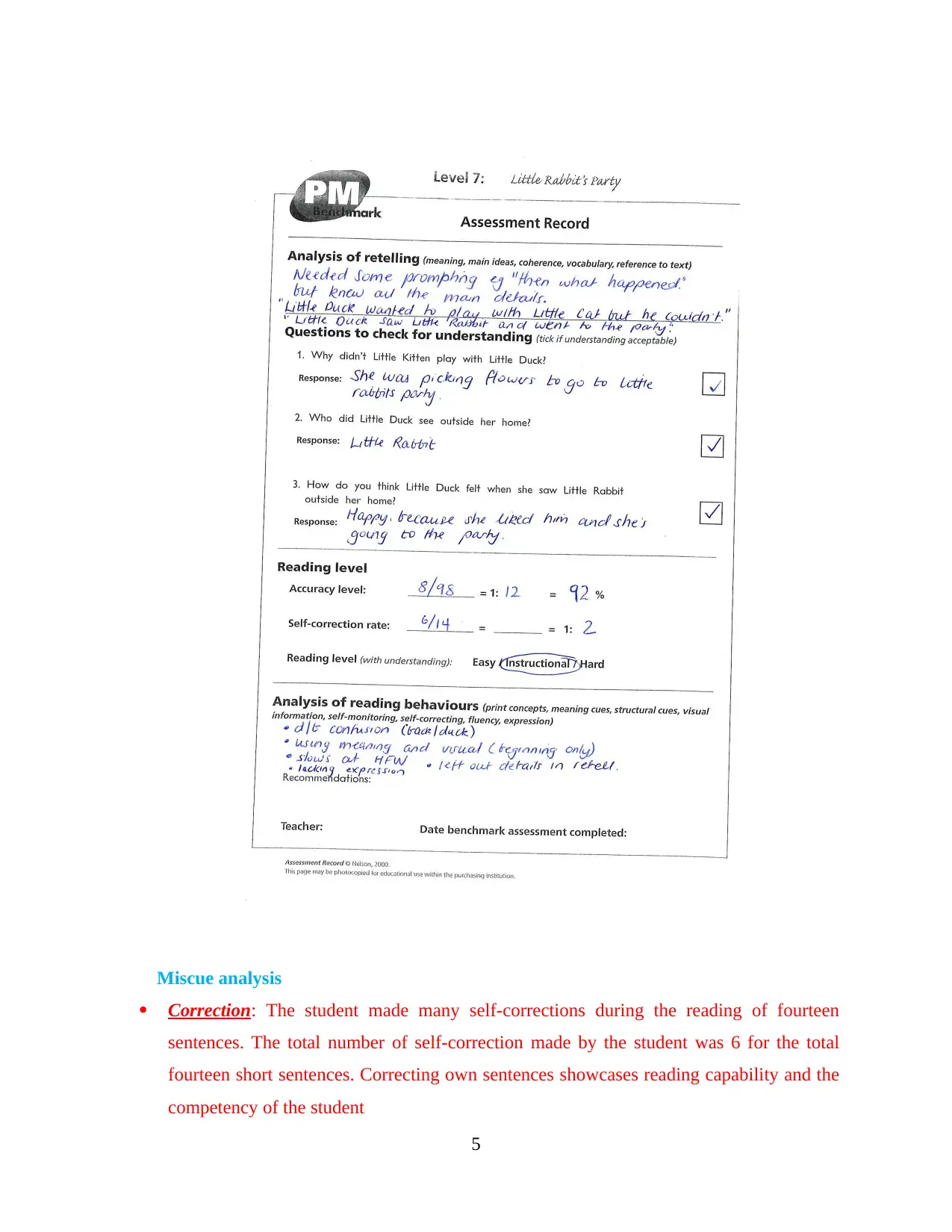
Miscue analysis
Correction: The student made many self-corrections during the reading of fourteen
sentences. The total number of self-correction made by the student was 6 for the total
fourteen short sentences. Correcting own sentences showcases reading capability and the
competency of the student
5
Correction: The student made many self-corrections during the reading of fourteen
sentences. The total number of self-correction made by the student was 6 for the total
fourteen short sentences. Correcting own sentences showcases reading capability and the
competency of the student
5
⊘ This is a preview!⊘
Do you want full access?
Subscribe today to unlock all pages.

Trusted by 1+ million students worldwide
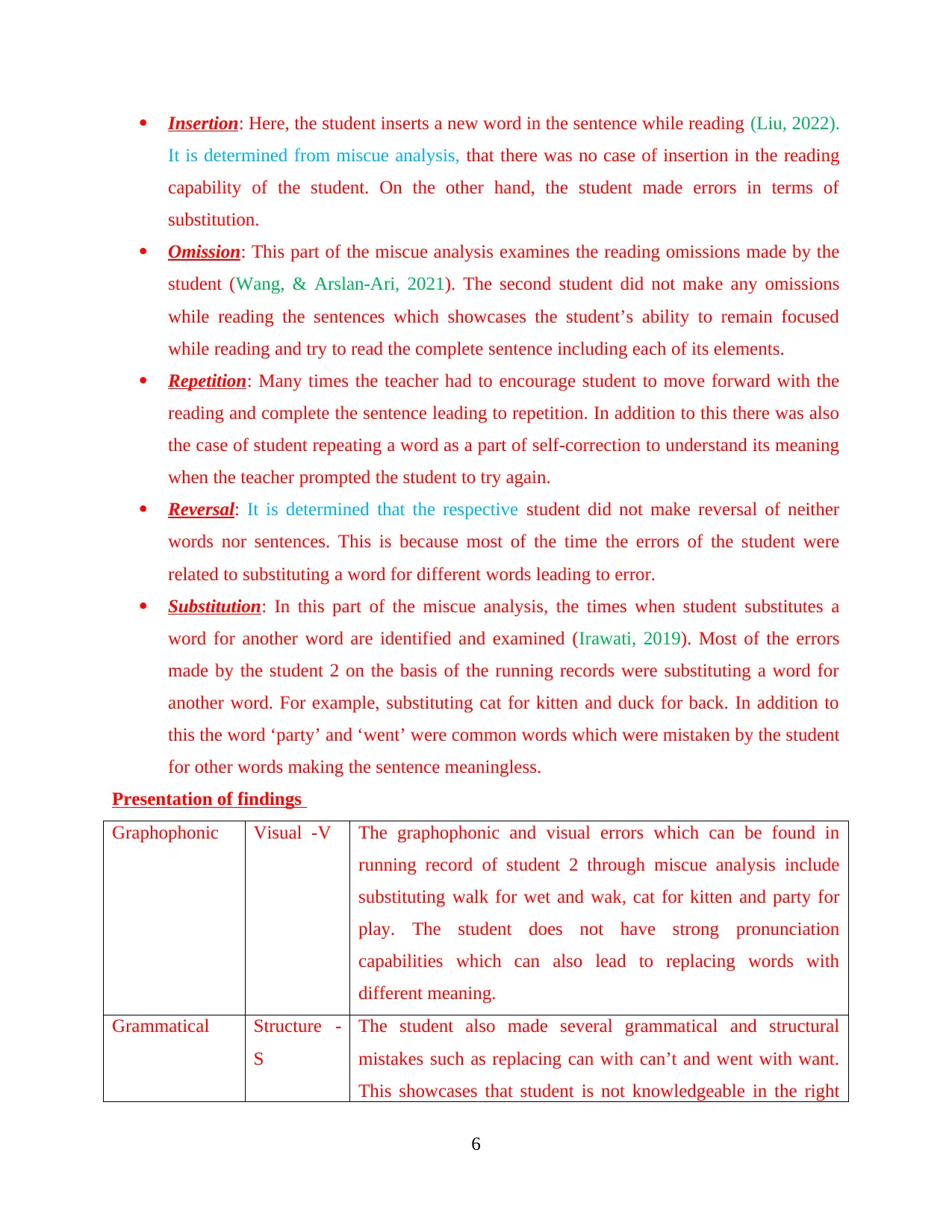
Insertion: Here, the student inserts a new word in the sentence while reading (Liu, 2022).
It is determined from miscue analysis, that there was no case of insertion in the reading
capability of the student. On the other hand, the student made errors in terms of
substitution.
Omission: This part of the miscue analysis examines the reading omissions made by the
student (Wang, & Arslan‐Ari, 2021). The second student did not make any omissions
while reading the sentences which showcases the student’s ability to remain focused
while reading and try to read the complete sentence including each of its elements.
Repetition: Many times the teacher had to encourage student to move forward with the
reading and complete the sentence leading to repetition. In addition to this there was also
the case of student repeating a word as a part of self-correction to understand its meaning
when the teacher prompted the student to try again.
Reversal: It is determined that the respective student did not make reversal of neither
words nor sentences. This is because most of the time the errors of the student were
related to substituting a word for different words leading to error.
Substitution: In this part of the miscue analysis, the times when student substitutes a
word for another word are identified and examined (Irawati, 2019). Most of the errors
made by the student 2 on the basis of the running records were substituting a word for
another word. For example, substituting cat for kitten and duck for back. In addition to
this the word ‘party’ and ‘went’ were common words which were mistaken by the student
for other words making the sentence meaningless.
Presentation of findings
Graphophonic Visual -V The graphophonic and visual errors which can be found in
running record of student 2 through miscue analysis include
substituting walk for wet and wak, cat for kitten and party for
play. The student does not have strong pronunciation
capabilities which can also lead to replacing words with
different meaning.
Grammatical Structure -
S
The student also made several grammatical and structural
mistakes such as replacing can with can’t and went with want.
This showcases that student is not knowledgeable in the right
6
It is determined from miscue analysis, that there was no case of insertion in the reading
capability of the student. On the other hand, the student made errors in terms of
substitution.
Omission: This part of the miscue analysis examines the reading omissions made by the
student (Wang, & Arslan‐Ari, 2021). The second student did not make any omissions
while reading the sentences which showcases the student’s ability to remain focused
while reading and try to read the complete sentence including each of its elements.
Repetition: Many times the teacher had to encourage student to move forward with the
reading and complete the sentence leading to repetition. In addition to this there was also
the case of student repeating a word as a part of self-correction to understand its meaning
when the teacher prompted the student to try again.
Reversal: It is determined that the respective student did not make reversal of neither
words nor sentences. This is because most of the time the errors of the student were
related to substituting a word for different words leading to error.
Substitution: In this part of the miscue analysis, the times when student substitutes a
word for another word are identified and examined (Irawati, 2019). Most of the errors
made by the student 2 on the basis of the running records were substituting a word for
another word. For example, substituting cat for kitten and duck for back. In addition to
this the word ‘party’ and ‘went’ were common words which were mistaken by the student
for other words making the sentence meaningless.
Presentation of findings
Graphophonic Visual -V The graphophonic and visual errors which can be found in
running record of student 2 through miscue analysis include
substituting walk for wet and wak, cat for kitten and party for
play. The student does not have strong pronunciation
capabilities which can also lead to replacing words with
different meaning.
Grammatical Structure -
S
The student also made several grammatical and structural
mistakes such as replacing can with can’t and went with want.
This showcases that student is not knowledgeable in the right
6
Paraphrase This Document
Need a fresh take? Get an instant paraphrase of this document with our AI Paraphraser
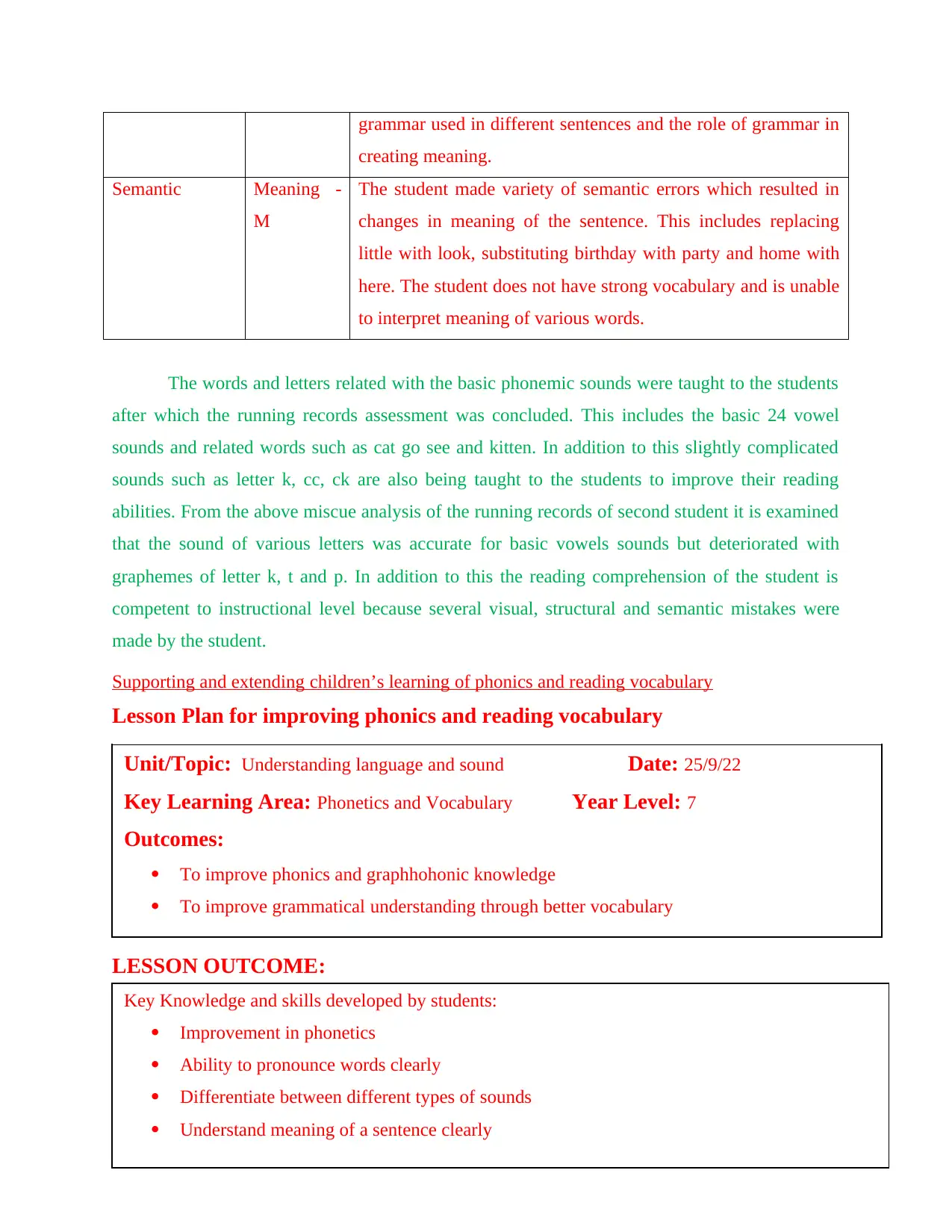
grammar used in different sentences and the role of grammar in
creating meaning.
Semantic Meaning -
M
The student made variety of semantic errors which resulted in
changes in meaning of the sentence. This includes replacing
little with look, substituting birthday with party and home with
here. The student does not have strong vocabulary and is unable
to interpret meaning of various words.
The words and letters related with the basic phonemic sounds were taught to the students
after which the running records assessment was concluded. This includes the basic 24 vowel
sounds and related words such as cat go see and kitten. In addition to this slightly complicated
sounds such as letter k, cc, ck are also being taught to the students to improve their reading
abilities. From the above miscue analysis of the running records of second student it is examined
that the sound of various letters was accurate for basic vowels sounds but deteriorated with
graphemes of letter k, t and p. In addition to this the reading comprehension of the student is
competent to instructional level because several visual, structural and semantic mistakes were
made by the student.
Supporting and extending children’s learning of phonics and reading vocabulary
Lesson Plan for improving phonics and reading vocabulary
LESSON OUTCOME:
7
Key Knowledge and skills developed by students:
Improvement in phonetics
Ability to pronounce words clearly
Differentiate between different types of sounds
Understand meaning of a sentence clearly
Unit/Topic: Understanding language and sound Date: 25/9/22
Key Learning Area: Phonetics and Vocabulary Year Level: 7
Outcomes:
To improve phonics and graphhohonic knowledge
To improve grammatical understanding through better vocabulary
creating meaning.
Semantic Meaning -
M
The student made variety of semantic errors which resulted in
changes in meaning of the sentence. This includes replacing
little with look, substituting birthday with party and home with
here. The student does not have strong vocabulary and is unable
to interpret meaning of various words.
The words and letters related with the basic phonemic sounds were taught to the students
after which the running records assessment was concluded. This includes the basic 24 vowel
sounds and related words such as cat go see and kitten. In addition to this slightly complicated
sounds such as letter k, cc, ck are also being taught to the students to improve their reading
abilities. From the above miscue analysis of the running records of second student it is examined
that the sound of various letters was accurate for basic vowels sounds but deteriorated with
graphemes of letter k, t and p. In addition to this the reading comprehension of the student is
competent to instructional level because several visual, structural and semantic mistakes were
made by the student.
Supporting and extending children’s learning of phonics and reading vocabulary
Lesson Plan for improving phonics and reading vocabulary
LESSON OUTCOME:
7
Key Knowledge and skills developed by students:
Improvement in phonetics
Ability to pronounce words clearly
Differentiate between different types of sounds
Understand meaning of a sentence clearly
Unit/Topic: Understanding language and sound Date: 25/9/22
Key Learning Area: Phonetics and Vocabulary Year Level: 7
Outcomes:
To improve phonics and graphhohonic knowledge
To improve grammatical understanding through better vocabulary
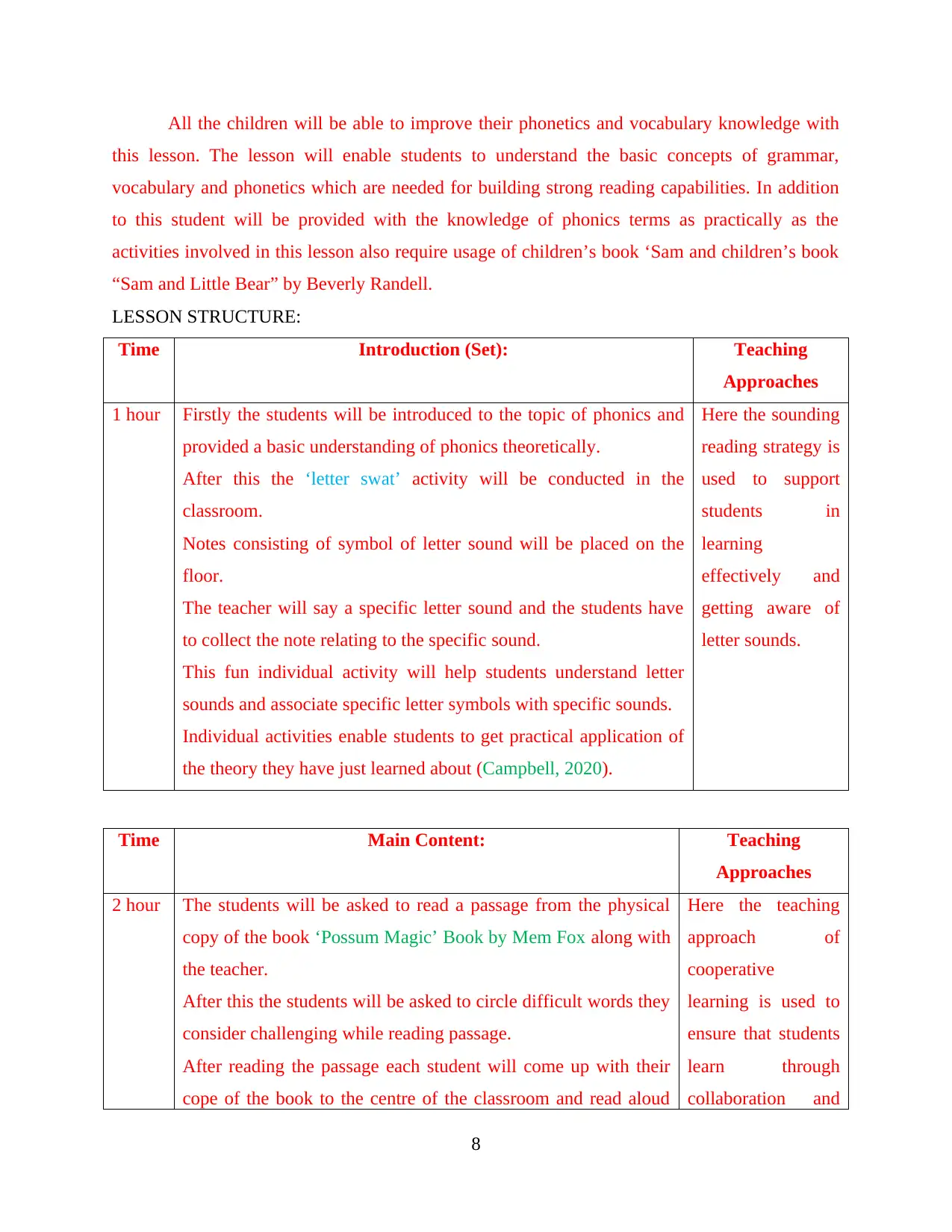
All the children will be able to improve their phonetics and vocabulary knowledge with
this lesson. The lesson will enable students to understand the basic concepts of grammar,
vocabulary and phonetics which are needed for building strong reading capabilities. In addition
to this student will be provided with the knowledge of phonics terms as practically as the
activities involved in this lesson also require usage of children’s book ‘Sam and children’s book
“Sam and Little Bear” by Beverly Randell.
LESSON STRUCTURE:
Time Introduction (Set): Teaching
Approaches
1 hour Firstly the students will be introduced to the topic of phonics and
provided a basic understanding of phonics theoretically.
After this the ‘letter swat’ activity will be conducted in the
classroom.
Notes consisting of symbol of letter sound will be placed on the
floor.
The teacher will say a specific letter sound and the students have
to collect the note relating to the specific sound.
This fun individual activity will help students understand letter
sounds and associate specific letter symbols with specific sounds.
Individual activities enable students to get practical application of
the theory they have just learned about (Campbell, 2020).
Here the sounding
reading strategy is
used to support
students in
learning
effectively and
getting aware of
letter sounds.
Time Main Content: Teaching
Approaches
2 hour The students will be asked to read a passage from the physical
copy of the book ‘Possum Magic’ Book by Mem Fox along with
the teacher.
After this the students will be asked to circle difficult words they
consider challenging while reading passage.
After reading the passage each student will come up with their
cope of the book to the centre of the classroom and read aloud
Here the teaching
approach of
cooperative
learning is used to
ensure that students
learn through
collaboration and
8
this lesson. The lesson will enable students to understand the basic concepts of grammar,
vocabulary and phonetics which are needed for building strong reading capabilities. In addition
to this student will be provided with the knowledge of phonics terms as practically as the
activities involved in this lesson also require usage of children’s book ‘Sam and children’s book
“Sam and Little Bear” by Beverly Randell.
LESSON STRUCTURE:
Time Introduction (Set): Teaching
Approaches
1 hour Firstly the students will be introduced to the topic of phonics and
provided a basic understanding of phonics theoretically.
After this the ‘letter swat’ activity will be conducted in the
classroom.
Notes consisting of symbol of letter sound will be placed on the
floor.
The teacher will say a specific letter sound and the students have
to collect the note relating to the specific sound.
This fun individual activity will help students understand letter
sounds and associate specific letter symbols with specific sounds.
Individual activities enable students to get practical application of
the theory they have just learned about (Campbell, 2020).
Here the sounding
reading strategy is
used to support
students in
learning
effectively and
getting aware of
letter sounds.
Time Main Content: Teaching
Approaches
2 hour The students will be asked to read a passage from the physical
copy of the book ‘Possum Magic’ Book by Mem Fox along with
the teacher.
After this the students will be asked to circle difficult words they
consider challenging while reading passage.
After reading the passage each student will come up with their
cope of the book to the centre of the classroom and read aloud
Here the teaching
approach of
cooperative
learning is used to
ensure that students
learn through
collaboration and
8
⊘ This is a preview!⊘
Do you want full access?
Subscribe today to unlock all pages.

Trusted by 1+ million students worldwide
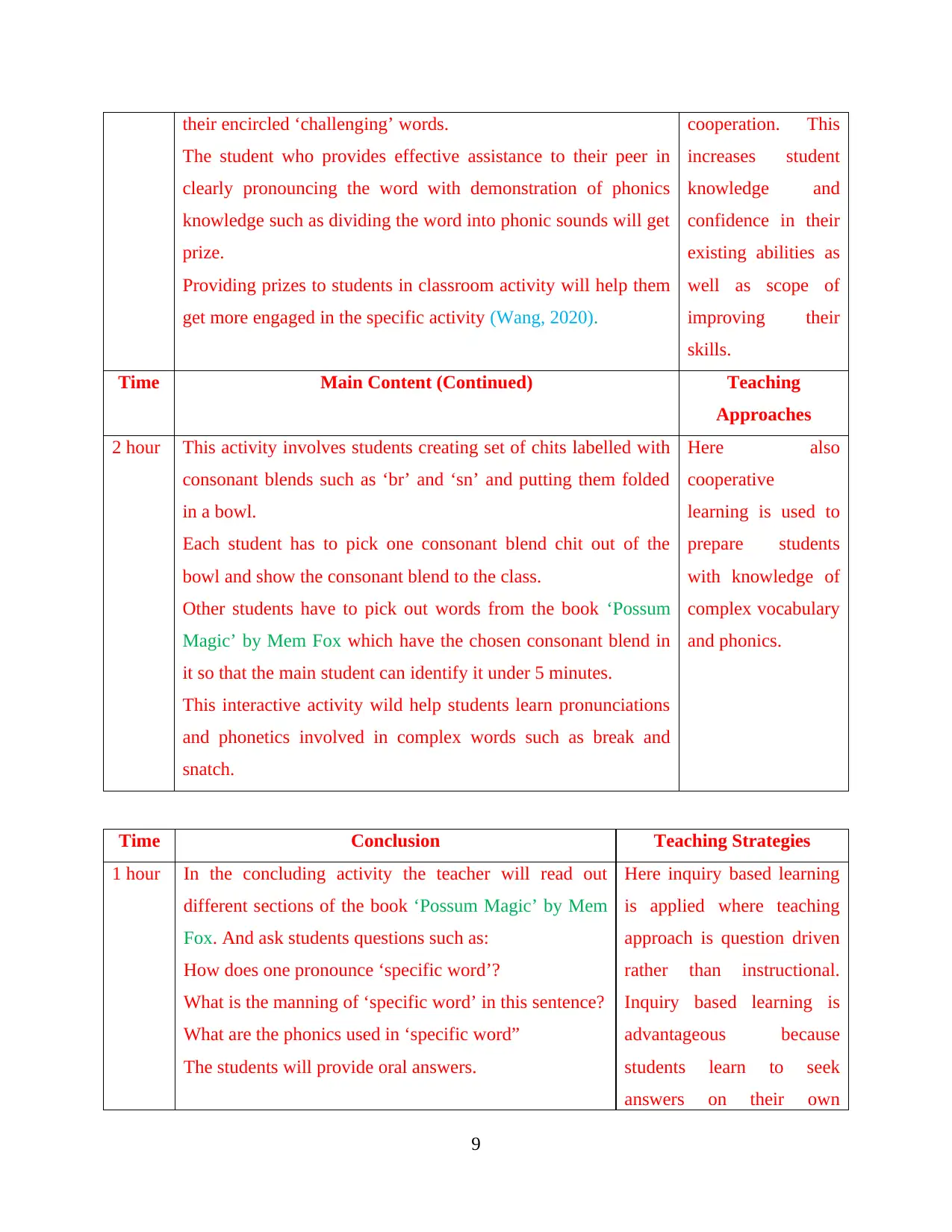
their encircled ‘challenging’ words.
The student who provides effective assistance to their peer in
clearly pronouncing the word with demonstration of phonics
knowledge such as dividing the word into phonic sounds will get
prize.
Providing prizes to students in classroom activity will help them
get more engaged in the specific activity (Wang, 2020).
cooperation. This
increases student
knowledge and
confidence in their
existing abilities as
well as scope of
improving their
skills.
Time Main Content (Continued) Teaching
Approaches
2 hour This activity involves students creating set of chits labelled with
consonant blends such as ‘br’ and ‘sn’ and putting them folded
in a bowl.
Each student has to pick one consonant blend chit out of the
bowl and show the consonant blend to the class.
Other students have to pick out words from the book ‘Possum
Magic’ by Mem Fox which have the chosen consonant blend in
it so that the main student can identify it under 5 minutes.
This interactive activity wild help students learn pronunciations
and phonetics involved in complex words such as break and
snatch.
Here also
cooperative
learning is used to
prepare students
with knowledge of
complex vocabulary
and phonics.
Time Conclusion Teaching Strategies
1 hour In the concluding activity the teacher will read out
different sections of the book ‘Possum Magic’ by Mem
Fox. And ask students questions such as:
How does one pronounce ‘specific word’?
What is the manning of ‘specific word’ in this sentence?
What are the phonics used in ‘specific word”
The students will provide oral answers.
Here inquiry based learning
is applied where teaching
approach is question driven
rather than instructional.
Inquiry based learning is
advantageous because
students learn to seek
answers on their own
9
The student who provides effective assistance to their peer in
clearly pronouncing the word with demonstration of phonics
knowledge such as dividing the word into phonic sounds will get
prize.
Providing prizes to students in classroom activity will help them
get more engaged in the specific activity (Wang, 2020).
cooperation. This
increases student
knowledge and
confidence in their
existing abilities as
well as scope of
improving their
skills.
Time Main Content (Continued) Teaching
Approaches
2 hour This activity involves students creating set of chits labelled with
consonant blends such as ‘br’ and ‘sn’ and putting them folded
in a bowl.
Each student has to pick one consonant blend chit out of the
bowl and show the consonant blend to the class.
Other students have to pick out words from the book ‘Possum
Magic’ by Mem Fox which have the chosen consonant blend in
it so that the main student can identify it under 5 minutes.
This interactive activity wild help students learn pronunciations
and phonetics involved in complex words such as break and
snatch.
Here also
cooperative
learning is used to
prepare students
with knowledge of
complex vocabulary
and phonics.
Time Conclusion Teaching Strategies
1 hour In the concluding activity the teacher will read out
different sections of the book ‘Possum Magic’ by Mem
Fox. And ask students questions such as:
How does one pronounce ‘specific word’?
What is the manning of ‘specific word’ in this sentence?
What are the phonics used in ‘specific word”
The students will provide oral answers.
Here inquiry based learning
is applied where teaching
approach is question driven
rather than instructional.
Inquiry based learning is
advantageous because
students learn to seek
answers on their own
9
Paraphrase This Document
Need a fresh take? Get an instant paraphrase of this document with our AI Paraphraser
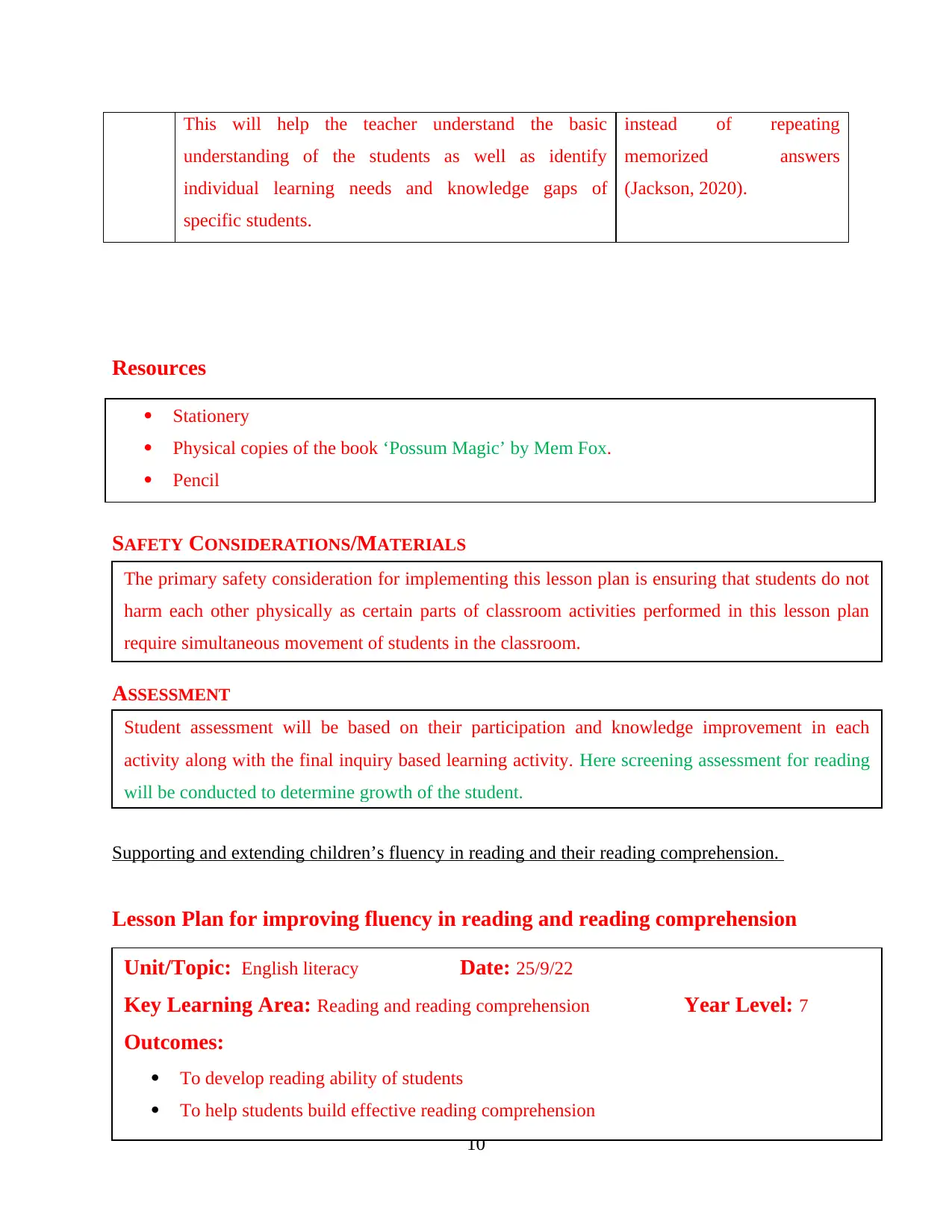
This will help the teacher understand the basic
understanding of the students as well as identify
individual learning needs and knowledge gaps of
specific students.
instead of repeating
memorized answers
(Jackson, 2020).
Resources
SAFETY CONSIDERATIONS/MATERIALS
ASSESSMENT
Supporting and extending children’s fluency in reading and their reading comprehension.
Lesson Plan for improving fluency in reading and reading comprehension
10
Stationery
Physical copies of the book ‘Possum Magic’ by Mem Fox.
Pencil
The primary safety consideration for implementing this lesson plan is ensuring that students do not
harm each other physically as certain parts of classroom activities performed in this lesson plan
require simultaneous movement of students in the classroom.
Student assessment will be based on their participation and knowledge improvement in each
activity along with the final inquiry based learning activity. Here screening assessment for reading
will be conducted to determine growth of the student.
Unit/Topic: English literacy Date: 25/9/22
Key Learning Area: Reading and reading comprehension Year Level: 7
Outcomes:
To develop reading ability of students
To help students build effective reading comprehension
understanding of the students as well as identify
individual learning needs and knowledge gaps of
specific students.
instead of repeating
memorized answers
(Jackson, 2020).
Resources
SAFETY CONSIDERATIONS/MATERIALS
ASSESSMENT
Supporting and extending children’s fluency in reading and their reading comprehension.
Lesson Plan for improving fluency in reading and reading comprehension
10
Stationery
Physical copies of the book ‘Possum Magic’ by Mem Fox.
Pencil
The primary safety consideration for implementing this lesson plan is ensuring that students do not
harm each other physically as certain parts of classroom activities performed in this lesson plan
require simultaneous movement of students in the classroom.
Student assessment will be based on their participation and knowledge improvement in each
activity along with the final inquiry based learning activity. Here screening assessment for reading
will be conducted to determine growth of the student.
Unit/Topic: English literacy Date: 25/9/22
Key Learning Area: Reading and reading comprehension Year Level: 7
Outcomes:
To develop reading ability of students
To help students build effective reading comprehension
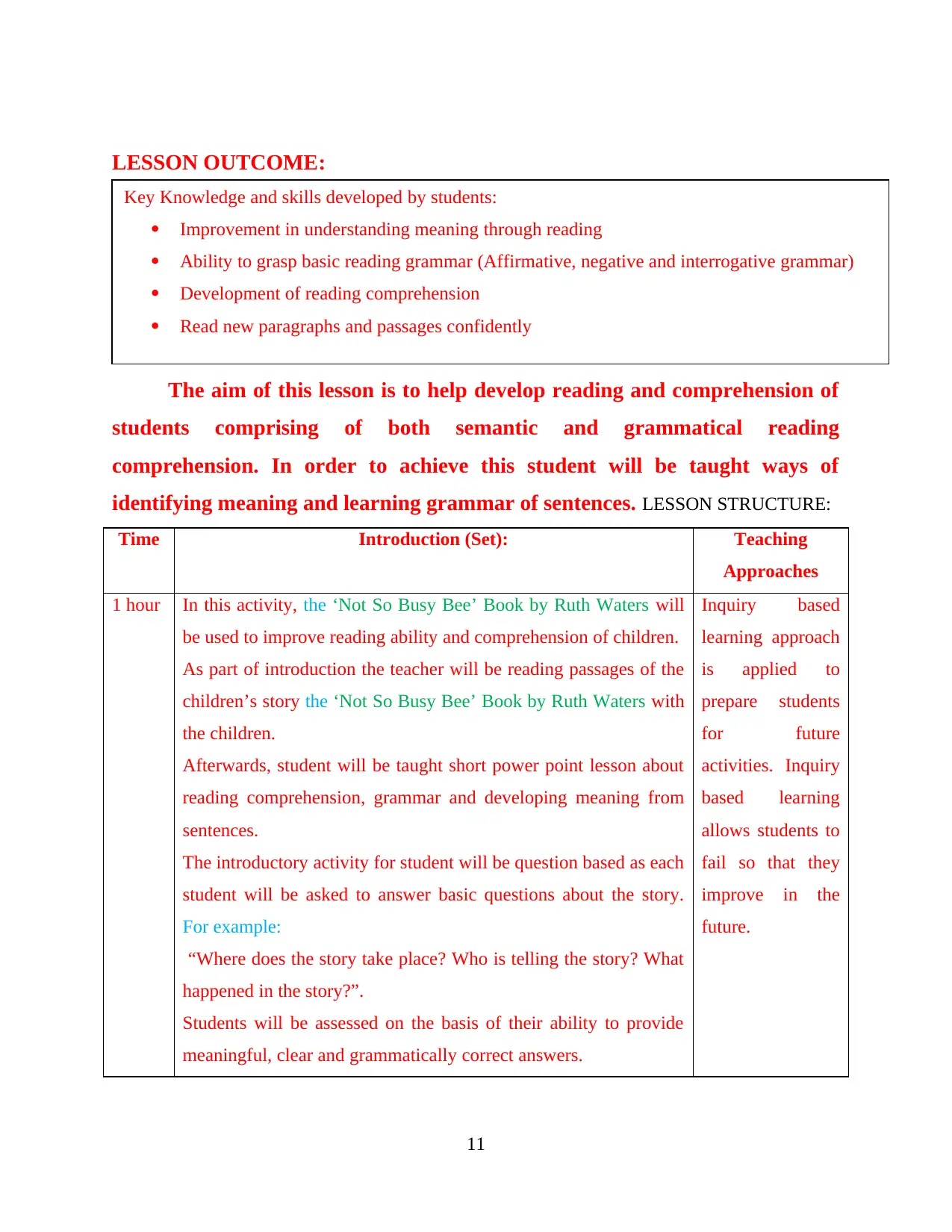
LESSON OUTCOME:
The aim of this lesson is to help develop reading and comprehension of
students comprising of both semantic and grammatical reading
comprehension. In order to achieve this student will be taught ways of
identifying meaning and learning grammar of sentences. LESSON STRUCTURE:
Time Introduction (Set): Teaching
Approaches
1 hour In this activity, the ‘Not So Busy Bee’ Book by Ruth Waters will
be used to improve reading ability and comprehension of children.
As part of introduction the teacher will be reading passages of the
children’s story the ‘Not So Busy Bee’ Book by Ruth Waters with
the children.
Afterwards, student will be taught short power point lesson about
reading comprehension, grammar and developing meaning from
sentences.
The introductory activity for student will be question based as each
student will be asked to answer basic questions about the story.
For example:
“Where does the story take place? Who is telling the story? What
happened in the story?”.
Students will be assessed on the basis of their ability to provide
meaningful, clear and grammatically correct answers.
Inquiry based
learning approach
is applied to
prepare students
for future
activities. Inquiry
based learning
allows students to
fail so that they
improve in the
future.
11
Key Knowledge and skills developed by students:
Improvement in understanding meaning through reading
Ability to grasp basic reading grammar (Affirmative, negative and interrogative grammar)
Development of reading comprehension
Read new paragraphs and passages confidently
The aim of this lesson is to help develop reading and comprehension of
students comprising of both semantic and grammatical reading
comprehension. In order to achieve this student will be taught ways of
identifying meaning and learning grammar of sentences. LESSON STRUCTURE:
Time Introduction (Set): Teaching
Approaches
1 hour In this activity, the ‘Not So Busy Bee’ Book by Ruth Waters will
be used to improve reading ability and comprehension of children.
As part of introduction the teacher will be reading passages of the
children’s story the ‘Not So Busy Bee’ Book by Ruth Waters with
the children.
Afterwards, student will be taught short power point lesson about
reading comprehension, grammar and developing meaning from
sentences.
The introductory activity for student will be question based as each
student will be asked to answer basic questions about the story.
For example:
“Where does the story take place? Who is telling the story? What
happened in the story?”.
Students will be assessed on the basis of their ability to provide
meaningful, clear and grammatically correct answers.
Inquiry based
learning approach
is applied to
prepare students
for future
activities. Inquiry
based learning
allows students to
fail so that they
improve in the
future.
11
Key Knowledge and skills developed by students:
Improvement in understanding meaning through reading
Ability to grasp basic reading grammar (Affirmative, negative and interrogative grammar)
Development of reading comprehension
Read new paragraphs and passages confidently
⊘ This is a preview!⊘
Do you want full access?
Subscribe today to unlock all pages.

Trusted by 1+ million students worldwide
1 out of 19
Related Documents
Your All-in-One AI-Powered Toolkit for Academic Success.
+13062052269
info@desklib.com
Available 24*7 on WhatsApp / Email
![[object Object]](/_next/static/media/star-bottom.7253800d.svg)
Unlock your academic potential
Copyright © 2020–2025 A2Z Services. All Rights Reserved. Developed and managed by ZUCOL.




